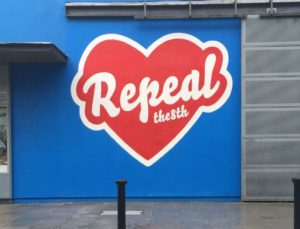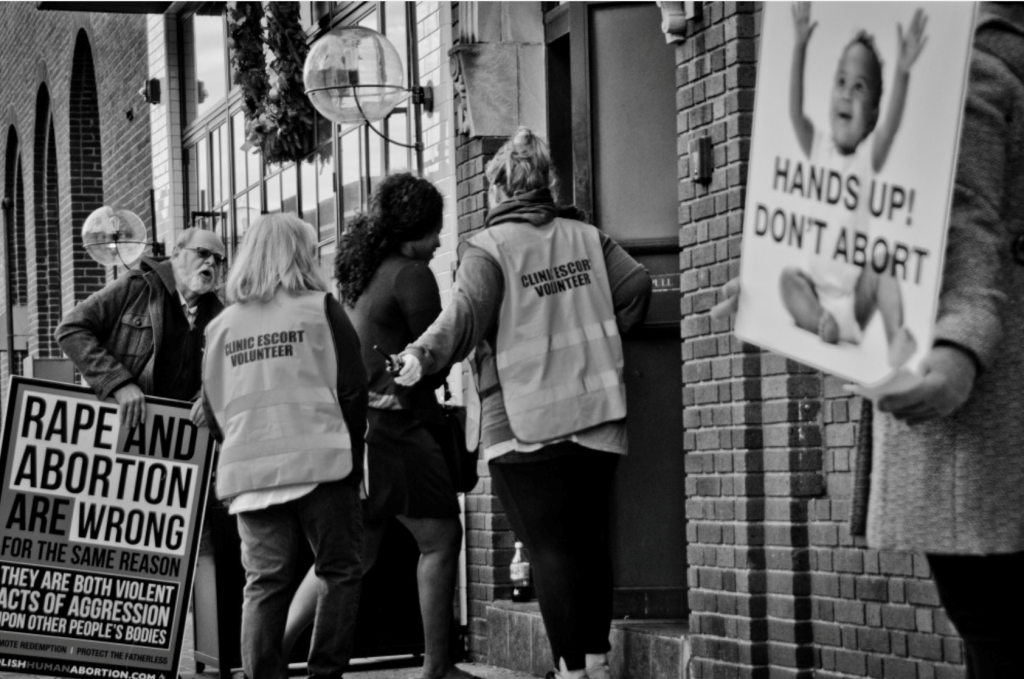Grace Gageby, Dublin, Ireland, SSH Blog Correspondent
In 1983, the 8th Amendment, a ban on abortion that gave the “right to life of the unborn with due regard to the equal life of the mother” was voted into the Irish constitution. The youngest person who voted in the referendum then is now 51.
Between the implementation of the 8th Amendment and the present day, a pro-choice movement has been struggling to secure a woman’s right to control her own body in Ireland. This September saw the 5th annual March for Choice, in which (despite bus strikes and abysmal weather) 25,000 people took to the streets of Dublin to call on the conservative political establishment to trust women to make their own choices.
Women and men of all ages marched through the city with signs declaring ‘My body, my choice’, ‘Get your rosaries off my ovaries”, ‘Woman, not vessel’, ‘Not the Church, not the State, women must decide their fate’, and, in reference to Ireland’s victory in the Marriage Equality campaign, ‘Choice: you gave it to the gays, now give it to the girls.’ Speeches at the end of the march drew attention to how Ireland’s abortion ban affects the most vulnerable women in society, for example, asylum seekers.
A tribute was paid to the 12 women a day who are forced to travel to England for abortions, in this moving rendition of the traditional song, ‘Trasna na Donnta’ (Irish for ‘Across the Waves’).
The past few months have seen a big focus on repealing the amendment. Sweaters with merely the word ‘repeal’ printed on them sold out in one day in a pop-up shop in Dublin city centre. All proceeds were given to the Abortion Rights Campaign, and across the country, men and women of all ages literally wore their beliefs on their chests.
 Street artist, Maser, graffitied a large red and white heart bearing the words “Repeal the 8th” on the wall of Dublin’s Project Art’s centre. The mural was painted over after Dublin City Council received complaints, which sparked mass outrage and indignation over this threat to freedom of speech. At a protest, I spoke to countless men and women who wanted to make the message abundantly clear: the issue of reproductive rights in Ireland cannot be covered up with a bit of blue paint.
Street artist, Maser, graffitied a large red and white heart bearing the words “Repeal the 8th” on the wall of Dublin’s Project Art’s centre. The mural was painted over after Dublin City Council received complaints, which sparked mass outrage and indignation over this threat to freedom of speech. At a protest, I spoke to countless men and women who wanted to make the message abundantly clear: the issue of reproductive rights in Ireland cannot be covered up with a bit of blue paint.
People in Ireland are no longer accepting the quintessential Irish problem of shoving matters under the carpet, and exiling women to England to receive medical treatment their own country refuses to provide. Since being painted over, the mural has become iconic, popping up all over the city on bags, shirts, badges, in shop windows, and even on donuts made by the fabulous Aungier Danger! In its suppression, the painting over of the mural spawned insurgence and sparked a conversation that cannot be muted by a backward establishment determined to dominate women’s sexual and personal decisions.
Unfortunately, Ireland’s history of silencing women’s oppression goes back further than the 8th amendment. In fact, the 8th was built on the legacy of the Magdalene Laundries, institutions run by the Catholic Church to house ‘fallen women’. The Magdalene Laundries were motivated by not only a desire for free labour, but, according to Frances Finnegan (author of Do Penance or Perish: A Study of Magdalene Asylums in Ireland), a need to “maintain moral and social order within the bounds of a patriarchal structure.” An estimated 30,000 women were confined in these laundries in the 19th and 20th century. Historically, there has been a culture of secrecy surrounding the laundries, and the abuse women faced within them. While Taoiseach Enda Kenny (Prime Minister of the Republic of Ireland) issued a formal apology in 2013, the religious institutions such as the Sisters of Mercy refused demands from the Irish government, UN Committee on Rights of the Child and the UN Committee Against Torture to contribute to the compensation fund for victims of the laundries.
With this history of oppression and silence, it is hardly surprising the archaic 8th amendment is currently in place in Ireland. It stems from centuries of Church and State control over women’s bodies.
Despite this, a youthful, vibrant pro-choice movement in Ireland is flourishing, having taken inspiration from the Yes Equality Campaign that legalised gay marriage in 2015. This victory was not only a joyous occasion for Ireland, but also for politicized sections of LGBT people, women and the working class who are currently at the forefront in the struggle for reproductive rights in Ireland. The sheer momentum behind the pro-choice movement in Ireland has created a massive drive for challenging sexism in all its facets.
If we want to achieve true gender equality in Ireland, we cannot and will not have a law policing women’s bodies in our constitution. If women are not equal in the eyes of the law, how can we expect the same thing in the hearts and minds of our citizens? Women’s bodies are not commodities: not vessels for children, not possessions of the State and not objects for the male gaze. We need to reject a culture of silencing oppression and of not listening to women’s stories, whether they be stories of assault, harassment, or being criminalized for having a say in their own reproductive rights. The current appetite for social change and challenging sexism in all it’s forms has created a platform from which women can be heard, and given Ireland’s history, it’s about time.
Grace is a student. She writes regularly for her school newsletter and yearbook, and has been published in Inis Magazine. Grace is currently involved with the socialist feminist group ROSA (for Reproductive rights, against Oppression, Sexism & Austerity), and their campaign for abortion rights in Ireland.

